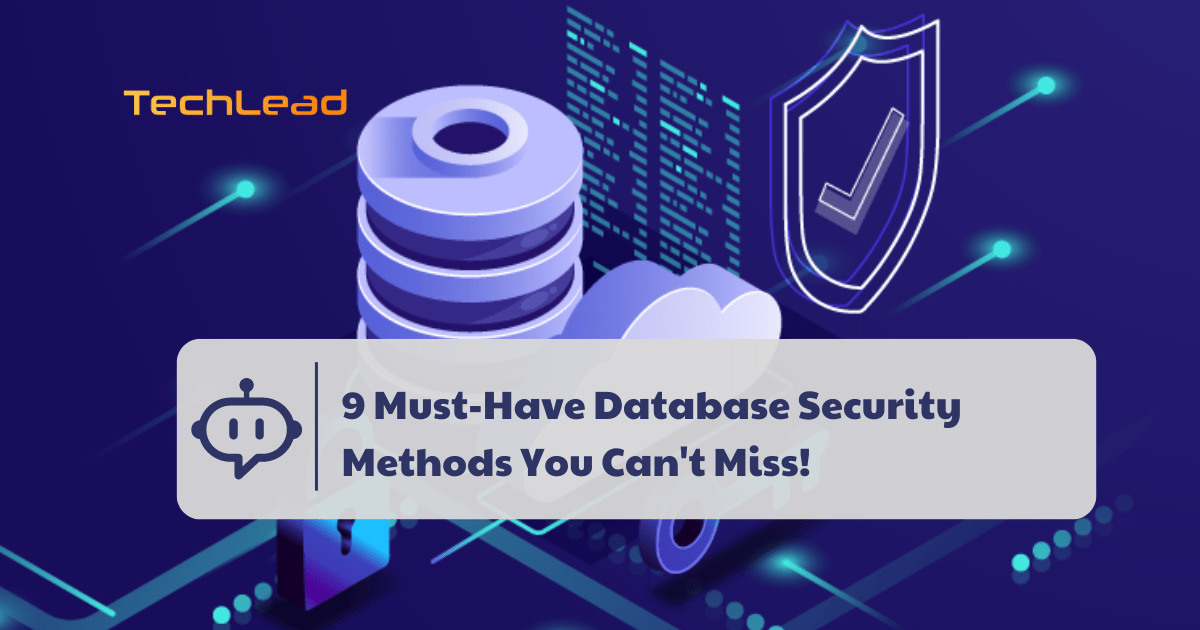In today’s digital age, database security is crucial. With increasing amounts of sensitive data, protecting against unauthorized access and breaches is essential. This article presents “9 Must-Have Database Security Methods You Can’t Miss!”
1. Data Encryption
Database Security has become paramount to protect sensitive information from unauthorized access and potential breaches. One of the most crucial techniques in ensuring robust Database Security is Data Encryption. This process transforms data from its original format into an encoded format, making it accessible only to those with the correct decryption key.
Data Encryption is a fundamental aspect of Database Security. It involves converting plaintext information into ciphertext, which can only be decoded by authorized entities possessing the decryption key. This process ensures that even if data is intercepted or stolen, it remains unreadable and secure from prying eyes.
Implementing Data Encryption significantly enhances Database Security. It protects data from unauthorized access, ensuring that even if malicious actors manage to bypass other security measures, the encrypted data remains inaccessible. This added layer of security is crucial for safeguarding sensitive information, such as personal, financial, and proprietary data, in the event of a breach.
Several tools and methods are essential for effective Data Encryption in Database Security. Advanced Encryption Standard (AES) and Rivest-Shamir-Adleman (RSA) are among the most widely used encryption algorithms. AES is known for its speed and security, making it suitable for encrypting large volumes of data. RSA, on the other hand, is commonly used for secure data transmission, leveraging its public-key cryptography for robust encryption. These tools, along with others like Elliptic Curve Cryptography (ECC), provide comprehensive encryption solutions to bolster Database Security.
In conclusion, Data Encryption is a critical component of Database Security, offering a robust mechanism to protect sensitive data from unauthorized access and breaches. By transforming data into an encoded format, encryption ensures that even compromised data remains secure. Utilizing advanced encryption tools and methods like AES and RSA can significantly enhance the security of any database, making Data Encryption indispensable for modern Database Security strategies.
2. Access Control
Access Control (Collected)
Access control is a critical aspect of database security, determining who has the right to access specific data within a system. By implementing robust access control measures, organizations can significantly mitigate the risk of unauthorized access and protect sensitive information. This is essential in maintaining the integrity and confidentiality of the database, which is a cornerstone of effective database security.
The primary benefit of access control is its ability to prevent unauthorized access, thereby safeguarding sensitive data. Unauthorized access can lead to data breaches, which can have severe consequences, including financial loss, reputational damage, and legal repercussions. By enforcing strict access control policies, organizations ensure that only authorized personnel can access, modify, or manage the data, thus enhancing overall database security.
Several methods can be employed to implement effective access control in a database security framework. User authentication is the first line of defense, verifying the identity of users before granting access to the database. Multi-factor authentication (MFA) adds an additional layer of security by requiring users to provide two or more verification factors, thereby significantly reducing the likelihood of unauthorized access. Role-based access control (RBAC) further refines access permissions by assigning specific rights and privileges based on the user’s role within the organization. This ensures that users can only access data necessary for their job functions, minimizing the risk of internal threats.
In conclusion, access control is a vital component of database security, crucial for preventing unauthorized access and protecting sensitive data. By employing user authentication, multi-factor authentication, and role-based access control, organizations can create a robust security framework that safeguards their databases against both external and internal threats. Effective access control not only enhances database security but also ensures regulatory compliance and fosters trust among stakeholders.
3. Backup and Recovery
One of the most essential aspects of database security is the implementation of effective backup and recovery strategies.
Backup and Recovery (Collected)
Backup and recovery processes are integral to maintaining robust database security. Regular data backups involve duplicating critical data at scheduled intervals to ensure that a recent copy is always available. This practice is vital for safeguarding against data loss due to unexpected events, such as hardware failures, cyberattacks, or human error. Effective backup strategies ensure that organizations can quickly restore their databases to a previous state, minimizing downtime and disruption.
The benefits of robust backup and recovery mechanisms in the realm of database security cannot be overstated. By having reliable backups, organizations can protect their data from permanent loss, ensuring business continuity even in the face of catastrophic events. This not only helps in maintaining operational efficiency but also boosts client and stakeholder confidence in the organization’s ability to manage and secure their data.
Various tools and solutions are available to enhance database security through backup and recovery. Cloud-based backup solutions offer scalability and offsite storage, protecting data from local disasters. Local backup options provide faster recovery times and control over data storage. Additionally, specialized software solutions enable automated backup processes and comprehensive recovery plans, further strengthening the organization’s database security.
In conclusion, implementing rigorous backup and recovery strategies is a cornerstone of effective database security. By regularly duplicating data and having robust recovery mechanisms in place, organizations can safeguard their critical information against loss and ensure quick restoration when necessary. As part of a comprehensive database security plan, these practices help maintain data integrity, support business continuity, and enhance overall resilience against various threats.
4. Monitoring and Analysis
Monitoring and Analysis (Collected)
Monitoring and analysis in Database Security entail the systematic observation and scrutiny of database activities, facilitated by advanced tools such as Security Information and Event Management (SIEM) systems and log servers. These tools act as vigilant guardians, capturing and analyzing logs to identify unauthorized access attempts, unusual patterns in data usage, or suspicious alterations to database configurations.
Effective monitoring and analysis not only ensures compliance with security policies but also empowers organizations to swiftly respond to security incidents. By correlating various data points and events, SIEM systems provide real-time insights into potential threats, enabling proactive measures to be taken to safeguard sensitive data.
The primary advantage of robust monitoring and analysis in Database Security lies in its ability to preemptively thwart security breaches. By maintaining a continuous vigil over database activities, organizations can promptly detect and neutralize threats posed by internal or external actors attempting unauthorized access or malicious activities.
Furthermore, the insights gained from comprehensive monitoring contribute to refining security protocols and enhancing incident response strategies. This proactive stance not only fortifies the overall security posture but also instills confidence among stakeholders regarding data integrity and confidentiality.
In conclusion, the implementation of diligent monitoring and analysis practices within Database Security is indispensable for safeguarding organizational assets in an increasingly digital landscape. By leveraging sophisticated tools like SIEM and log servers, businesses can proactively defend against emerging threats and maintain robust data protection measures. Embracing these practices not only ensures regulatory compliance but also fosters a resilient security framework capable of adapting to evolving cybersecurity challenges.
5. Patch Management and Updates
In the realm of Database Security, effective Patch Management and Updates play a critical role in safeguarding sensitive information. This process involves regularly updating database software to fix known security vulnerabilities, thereby fortifying the system against potential cyber threats.
Database Security hinges significantly on robust Patch Management and Updates. By promptly addressing identified security flaws through scheduled updates, organizations can mitigate the risk of exploitation by malicious actors. This proactive approach ensures that databases remain resilient against evolving cyber threats.
Implementing a structured approach to Patch Management and Updates is imperative for maintaining a secure database environment. This includes adhering to a routine update schedule and diligently monitoring security advisories from software vendors. By staying informed and proactive, organizations can swiftly deploy patches that shore up vulnerabilities and enhance overall database security.
In conclusion, effective Patch Management and Updates are indispensable components of comprehensive Database Security strategies. By consistently applying updates and monitoring security bulletins, organizations bolster their defenses against potential cyber attacks. Embracing proactive patch management not only safeguards sensitive data but also upholds the integrity and reliability of database systems in an increasingly interconnected digital landscape.
6. Network Security
Network Security (Collected)
Database security is paramount in today’s digital landscape where data breaches can lead to severe consequences. Among the critical strategies to safeguard databases, network security plays a pivotal role. It involves implementing various measures to prevent unauthorized access from external sources, thereby ensuring the integrity and confidentiality of sensitive information.
Network security encompasses a range of techniques aimed at fortifying the perimeter around databases to thwart external threats. Key methods include:
- Firewalls: These are essential barriers that monitor and control incoming and outgoing network traffic based on predetermined security rules. By strategically placing firewalls, organizations can filter out malicious data packets and prevent unauthorized access attempts to databases.
- Virtual Private Networks (VPNs): VPNs establish secure, encrypted connections over public networks, enabling remote users to access databases securely. By encrypting data transmissions, VPNs ensure that sensitive information remains protected from eavesdropping and interception during transmission.
- Intrusion Detection and Prevention Systems (IDS/IPS): IDS/IPS are sophisticated technologies designed to detect and respond to potential malicious activities or policy violations in real-time. IDS monitors network traffic for suspicious patterns or anomalies, while IPS actively blocks or mitigates identified threats to prevent unauthorized access to databases.
Benefits of Network Security for Database Security
The implementation of robust network security measures offers several benefits:
- Preventing Unauthorized Access: By deploying firewalls, VPNs, and IDS/IPS, organizations can effectively block unauthorized attempts to access databases from external networks. This proactive approach minimizes the risk of data breaches and unauthorized data manipulation.
- Enhancing Data Confidentiality: Encryption mechanisms employed by VPNs ensure that data transmitted between users and databases remains confidential. This confidentiality protection is crucial in safeguarding sensitive information such as personal identifiers or financial records.
- Maintaining Data Integrity: IDS/IPS continuously monitor network traffic to detect and mitigate threats that could compromise the integrity of databases. By promptly identifying and responding to suspicious activities, these systems help uphold the accuracy and reliability of stored data.
In conclusion, network security measures are indispensable components of comprehensive database security strategies. By leveraging firewalls, VPNs, and IDS/IPS, organizations can effectively mitigate external threats and safeguard their databases against unauthorized access and potential data breaches. Embracing these technologies not only enhances data confidentiality and integrity but also fortifies the overall security posture of enterprises in an increasingly interconnected digital environment.
7. Employee Training
Employee Training (Collected)
In the realm of Database Security, ensuring robust protection mechanisms is paramount to safeguarding sensitive information against unauthorized access and breaches. While technological solutions play a crucial role, the human element remains equally vital. One of the pivotal aspects in fortifying database security involves Employee Training.
Employee Training is a proactive strategy aimed at enhancing awareness and understanding of security protocols among staff members within an organization. It revolves around educating employees on the significance of adhering to stringent security measures and protocols when handling sensitive data.
The concept of Employee Training in Database Security revolves around instilling a culture of vigilance and responsibility among employees. By imparting knowledge about potential threats and best practices, organizations empower their workforce to recognize and mitigate risks effectively.
The primary benefit of comprehensive Employee Training in Database Security is the mitigation of human errors and vulnerabilities. Educated employees are less likely to inadvertently compromise data integrity or fall victim to social engineering tactics, thereby reducing the overall risk exposure of the organization.
Implementing regular training sessions and structured security awareness programs are foundational methods in cultivating a security-conscious workforce. These initiatives include simulated phishing exercises, workshops on data handling best practices, and updates on emerging threats and compliance requirements.
In conclusion, while advanced technological solutions are crucial for fortifying Database Security, the role of Employee Training cannot be overstated. By investing in continuous education and awareness programs, organizations not only mitigate risks but also foster a security-oriented culture that permeates throughout their operations. Effective Employee Training is not merely a compliance measure but a strategic initiative that bolsters the overall resilience of database security frameworks.
By prioritizing Employee Training alongside technological advancements, organizations can proactively defend against evolving threats and ensure the integrity and confidentiality of their valuable data assets.
8. Segregation of Duties
In the realm of Database Security, one critical aspect often overlooked is the principle of Segregation of Duties. This principle revolves around the strategic division of privileges and responsibilities within an organization’s database management framework. By ensuring that no single individual possesses unrestricted access and modification rights, organizations mitigate the risks associated with potential misuse of authority.
Segregation of Duties (SoD) plays a pivotal role in bolstering Database Security by systematically distributing tasks and permissions among different roles within an organization. This practice serves to prevent any single user from having complete control over sensitive data, thereby reducing the likelihood of unauthorized access or malicious activities.
Implementing SoD involves establishing clear roles and responsibilities for database administrators, developers, and other personnel involved in data management. Each role is assigned specific privileges tailored to their operational requirements, ensuring that critical tasks such as data access, modification, and configuration are performed only by authorized individuals.
Regular audits and evaluations are integral to maintaining the effectiveness of SoD. By periodically reviewing access rights and permissions, organizations can identify and rectify any discrepancies or potential vulnerabilities promptly. This proactive approach not only fortifies the database infrastructure but also aligns with regulatory compliance requirements, thereby safeguarding sensitive information from unauthorized access or manipulation.
In conclusion, Segregation of Duties stands as a cornerstone in the realm of Database Security, offering a structured approach to mitigate risks associated with unauthorized access and misuse of privileges. By establishing clear boundaries and responsibilities, organizations not only enhance operational efficiency but also uphold the integrity and confidentiality of their data assets. Embracing SoD ensures a robust defense mechanism against internal and external threats, underscoring its indispensable role in safeguarding databases in today’s digitally interconnected landscape.
9. Adopting New Technologies
In the realm of Database Security, staying abreast of technological advancements is crucial to fortifying data protection against evolving threats. Adopting cutting-edge technologies not only enhances security measures but also safeguards sensitive information from sophisticated cyber attacks.
Adopting new technologies involves integrating the latest advancements to bolster Database Security. This proactive approach ensures that databases are fortified with state-of-the-art defenses, capable of thwarting modern cyber threats.
By leveraging emerging technologies, organizations can significantly enhance Database Security. These technologies offer advanced encryption mechanisms, real-time threat detection, and resilient data storage solutions, thereby mitigating risks associated with data breaches and unauthorized access.
Examples of such technologies include:
- Blockchain: Utilized for its immutable ledger technology, enhancing data integrity and traceability within databases.
- Artificial Intelligence (AI): Employs machine learning algorithms to detect anomalies and predict potential security breaches, enabling proactive threat mitigation.
- Cloud Security Solutions: Offers scalable and secure storage options, integrating robust encryption and access control measures to safeguard sensitive data stored in cloud environments.
In conclusion, integrating new technologies into Database Security strategies is imperative for safeguarding organizational data in today’s digital landscape. By embracing innovations like blockchain, AI, and cloud security solutions, businesses can fortify their databases against emerging threats and maintain data integrity and confidentiality
10. Conclusion
In conclusion, the field of Database Security encompasses various crucial methods to safeguard sensitive information. It is paramount to implement a comprehensive approach integrating encryption, access control, backup and recovery processes, monitoring and auditing mechanisms, timely patch management, and the adoption of new technologies. These strategies collectively fortify database defenses against potential threats and unauthorized access, ensuring the integrity and confidentiality of data. Businesses are strongly encouraged to initiate immediate deployment of these security measures to safeguard their valuable data assets effectively.





